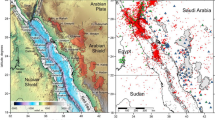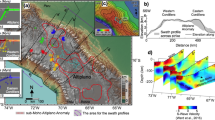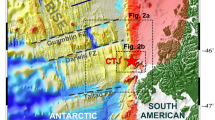Abstract
During the early stages in the formation of divergent margins, the lithosphere experiences large changes in temperature that can determine its strength and influence magma generation1,2. This, in turn, may play a key role in continental rifting, break-up, and subsequent subsidence. Here we present surface heat-flow data from the Eastern Gulf of Aden, which is a recently formed divergent margin between Africa and Arabia3. In the deeper parts of the margin the heat flow is high and constant, but it decreases abruptly near the shelf-slope. Our numerical models, in conjunction with geophysical and geological constraints, suggest that the data are best explained by a thermal anomaly in the upper mantle that has persisted after continental break-up. We suggest that this anomaly is related to small-scale convection that occurred during and after rifting. Similar anomalies could have characterized other divergent margins: for example, the presence of shallow-water sediments deposited after the opening of the Atlantic Ocean4,5,6 hints at lower subsidence than would have occurred in the absence of persistent thermal anomalies.
This is a preview of subscription content, access via your institution
Access options
Subscribe to this journal
Receive 12 print issues and online access
$259.00 per year
only $21.58 per issue
Buy this article
- Purchase on Springer Link
- Instant access to full article PDF
Prices may be subject to local taxes which are calculated during checkout




Similar content being viewed by others
References
Huismans, R. S. & Beaumont, C. Complex rifted continental margins explained by dynamical models of depth-dependent lithospheric extension. Geology 36, 163–166 (2008).
Lavier, L. L. & Manatschal, G. A mechanism to thin the continental lithosphere at magma-poor margins. Nature 440, 324–328 (2006).
Leroy, S. et al. From rifting to spreading in the eastern Gulf of Aden: A geophysical survey of a young oceanic basin from margin to margin. Terra Nova 16, 185–192 (2004).
Bolli, H. M. Synthesis of the leg 40 biostratigraphy and paleontology. Deep Sea Drilling Project Proc. XL, 1063–1067 (1978).
Wilson, R. C. L., Manatschal, G. & Wise, S. W. in Non-Volcanic Rifting of Continental Margins: Evidence from Land and Sea (eds Wilson, R. C. L., Whitmarsh, R. B., Taylor, B. & Froitzheim, N.) 429–452 (Geological Society of London, Spec. Publ., 2001).
Moulin, M. et al. Geological constraints on the evolution of the Angolan margin based on reflection and refraction seismic data (ZaiAngo project). Geophys. J. Int. 162, 793–810 (2005).
Pasyanos, M. E. & Nyblade, A. A. A top to bottom lithospheric study of Africa and Arabia. Tectonophysics 444, 27–44 (2007).
Whitmarsh, R. B., Manatschal, G. & Minshull, T. A. Evolution of magma-poor continental margins from rifting to seafloor spreading. Nature 413, 150–154 (2001).
Leroy, S. et al. AGU Fall Meeting (AGU, 2006).
Stein, C. S. & Stein, S. A model for the global variation in oceanic depth and heat flow with lithospheric age. Nature 359, 123–129 (1992).
d’Acremont, E. et al. Structure and evolution of the eastern Gulf of Aden conjugate margins from seismic reflection data. Geophys. J. Int. 160, 869–890 (2005).
Gettings, M. E. A heat flow profile across the Arabian Shield and Red Sea. EOS Trans. AGU 62, 407 (1981).
Cochran, J. R. Simple models of diffuse extension and the pre-seafloor spreading development of the continental margin of the Northeastern Gulf of Aden. Oceanologica Acta sp., 155–165 (1981).
Gernigon, L. et al. A moderate melting model for the Vøring margin (Norway) based on structural observations and a thermo-kinematical modelling: Implication for the meaning of the lower crustal bodies. Tectonophysics 412, 255–278 (2006).
Parsons, B. & Sclater, J. G. An analysis of the variation of ocean floor bathymetry and heat flow with age. J. Geophys. Res. 82, 803–827 (1977).
Royden, L. H. & Keen, C. E. Rifting process and thermal evolution of the continental margin of Eastern Canada determined from subsidence curves. Earth Planet. Sci. Lett. 51, 343–361 (1980).
Kusznir, N. J. & Karner, G. D. Continental lithospheric thinning and breakup in response to upwelling divergent mantle flow: Application to the Woodlark, Newfoundland and Iberia margins. Geological Society, London, Special Publications 282, 389–419 (2007).
Lowell, R. P. & Rona, P. A. Seafloor hydrothermal systems driven by the serpentinization of peridotite. Geophys. Res. Lett. 29, 1531 (2002).
Boutillier, R. R. & Keen, C. E. Small-scale convection and divergent plate boundaries. J. Geophys. Res. 104, 7389–7403 (1999).
King, S. D. & Anderson, D. L. Edge-driven convection. Earth Planet. Sci. Lett. 160, 289–296 (1998).
Fernandez, M. et al. Deep structure of the Voring Margin: the transition from a continental shield to a young oceanic lithosphere. Earth Planet. Sci. Lett. 221, 131–144 (2004).
Scheck-Wenderoth, M. & Maystrenko, Y. How warm are passive continental margins? A 3-D lithosphere-scale study from the Norwegian margin. Geology 36, 419–422 (2008).
Goutorbe, B., Lucazeau, F. & Bonneville, A. Surface heat flow and the mantle contribution on the margins of Australia. Geochem. Geophys. Geosyst. 9, Q05011 (2008).
King, S. D. & Ritsema, J. African hot spot volcanism: Small-scale convection in the upper mantle beneath cratons. Science 290, 1137–1140 (2000).
Holbrook, W. S. & Kelemen, P. B. Large igneous province on the US Atlantic margin and implications for magmatism during continental breakup. Nature 364, 433–436 (1993).
Hopper, J. R., Mutter, J. C., Larson, R. L. & Mutter, C. Z. Magmatism and rift margin evolution: Evidence from northwest Australia. Geology 20, 853–857 (1992).
Moretti, I. & Chénet, P. Y. The evolution of the Suez rift: A combination of stretching and secondary convection. Tectonophysics 133, 229–234 (1987).
d’Acremont, E. et al. Structure and Evolution of the eastern Gulf of Aden: Insights from magnetic and gravity data (Encens-Sheba cruise). Geophys. J. Int. 165, 786–803 (2006).
Acknowledgements
This work was funded by DyETI, GDR Marge and INSU. IFREMER provided marine facilities. We thank A. Al Laski from the Sultan Qaboos University, H. Al Azri from the Directorate of Mines in Muscat and the crew of R/V ‘Le Suroît’. This is IPGP contribution no. 2426.
Author information
Authors and Affiliations
Contributions
F.L. and S.L. were principal investigators of the ENCENS-FLUX survey. F.L. developed the numerical modelling and processed the heat-flow data reduction. B.G. processed oil exploration data. S.L., E.D. and L.W. processed seismic data. A.B., B.G., P.T., F.L., S.L. and E.D. prepared and operated the heat-flow instrument. All authors participated in the ENCENS-FLUX cruise (except K.A.T.), discussed the scientific issues and commented on the manuscript.
Corresponding author
Supplementary information
Supplementary Information
Supplementary Information (PDF 5234 kb)
Rights and permissions
About this article
Cite this article
Lucazeau, F., Leroy, S., Bonneville, A. et al. Persistent thermal activity at the Eastern Gulf of Aden after continental break-up. Nature Geosci 1, 854–858 (2008). https://doi.org/10.1038/ngeo359
Received:
Accepted:
Published:
Issue Date:
DOI: https://doi.org/10.1038/ngeo359
This article is cited by
-
Upper mantle viscosity and dynamic subsidence of curved continental margins
Nature Communications (2013)
-
Post-rift vertical movements and horizontal deformations in the eastern margin of the Central Atlantic: Middle Jurassic to Early Cretaceous evolution of Morocco
International Journal of Earth Sciences (2012)
-
From rifting to oceanic spreading in the Gulf of Aden: a synthesis
Arabian Journal of Geosciences (2012)



